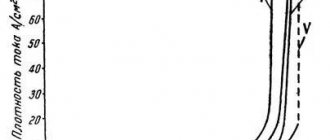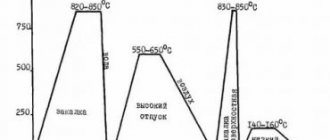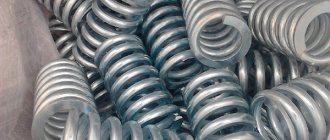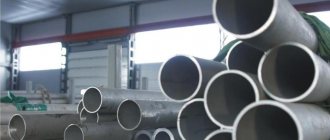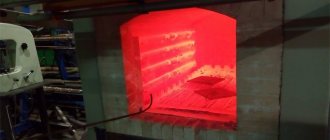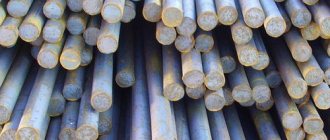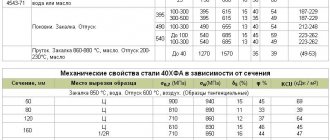The influence of chem. elements on the properties of steel.
Symbols of chemical elements:
INFLUENCE OF IMPURITIES ON STEEL AND ITS PROPERTIES
Carbon - found in steel usually in the form of a chemical compound Fe3C called cementite. With an increase in carbon content to 1.2%, the hardness, strength and elasticity of steel increase, but ductility and impact resistance decrease, and workability deteriorates, and weldability also deteriorates.
Silicon - if it is contained in steel in small quantities, it does not have a special effect on its properties. (Useful impurity; introduced as an active deoxidizer and remains in the steel in an amount of 0.4%)
Manganese , like silicon, is found in ordinary carbon steel in small quantities and does not have any particular effect on its properties. (A useful impurity; introduced into steel for deoxidation and remains in it in an amount of 0.3-0.8%. Manganese reduces the harmful effects of oxygen and sulfur.
Sulfur is a harmful impurity. It is found in steel mainly in the form of FeS. This compound makes the steel brittle at high temperatures, such as during forging, a property called red brittleness. Sulfur increases the abrasion of steel, reduces fatigue resistance and reduces corrosion resistance. In carbon steel, no more than 0.06-0.07% sulfur is allowed. (Steel is protected from red brittleness by manganese, which binds sulfur into MnS sulfides).
Phosphorus is also a harmful impurity. Reduces viscosity at low temperatures, that is, it causes cold brittleness. Phosphorus somewhat improves the machinability of steel, as it promotes chip separation.
ALLOYING ELEMENTS AND THEIR INFLUENCE ON STEEL PROPERTIES
Chromium (X) is the cheapest and most common element. It increases hardness and strength, slightly reducing ductility, and increases corrosion resistance; the content of large amounts of chromium makes the steel stainless and ensures resistance to magnetic forces
.
Nickel (N) - imparts corrosion resistance
, high strength and ductility,
increases hardenability
, affects the change in the coefficient of thermal expansion. Nickel is an expensive metal; they are trying to replace it with a cheaper one.
Tungsten (B) - forms very hard chemical compounds in steel - carbides, which sharply increase hardness and red-hardness. Tungsten prevents grain growth when heated and helps eliminate brittleness during tempering. This is an expensive and scarce metal.
Vanadium (F) - increases hardness and strength, grinds grain. It increases the density of steel, as it is a good deoxidizer; it is expensive and scarce.
Silicon (C) - in quantities above 1% has a special effect on the properties of steel: a content of 1-1.5% Si increases strength, while the toughness is maintained. With a higher silicon content, electrical resistance and magnetic permeability increase. Silicon also increases elasticity, acid resistance, and scale resistance.
Manganese (G) - with a content above 1% increases hardness
, wear resistance, resistance to shock loads, without reducing ductility.
Cobalt (K) - increases heat resistance, magnetic properties, increases impact resistance.
Molybdenum (M) - increases red hardness, elasticity, tensile strength, anti-corrosion properties and resistance to oxidation at high temperatures
.
Titanium (T) - increases the strength and density of steel
, promotes grain refinement, is a good deoxidizer, improves workability and corrosion resistance.
Niobium (B) - improves acid resistance and helps reduce corrosion in welded structures.
Aluminum (U) - increases heat resistance and scale resistance.
Copper (D) - increases anti-corrosion properties; it is introduced mainly into construction steel.
Cerium - increases strength and especially ductility.
Zirconium (Z) - has a special effect on the size and growth of grain in steel, refines the grain and makes it possible to obtain steel with a predetermined grain size.
Lanthanum, cesium, neodymium - reduce porosity, help reduce the sulfur content in steel, improve surface quality, and refine grain.
Stainless steels: how composition affects properties
Alloy steels occupy a significant share of the metallurgical products market. These include the so-called “stainless steels” - a group of alloys characterized by increased resistance to corrosion. Since their appearance, the range of such steels has expanded to several hundred items. Therefore, a system for their classification and labeling was developed.
It is worth noting that the name “stainless steel” does not entirely correctly reflect its properties. Any iron-carbon alloy is exposed to oxygen and aggressive substances, but for this to affect its performance properties, it takes different times. Therefore, stainless steels are more correctly called corrosion-resistant.
Classification of stainless steels
By composition
Chromium, nickel, vanadium, molybdenum, titanium and some others are used as alloying additives that increase the resistance of the iron-carbon alloy to rust formation. Corrosion resistance is also increased by manganese and silicon introduced to deoxidize and neutralize sulfur. Based on the main alloying elements, stainless steels are classified as chromium, manganese, etc. Some additives are used to impart special structural or technological properties to steels, for example, to crush carbides and increase impact strength.
The basic alloying elements of stainless steel are chromium and nickel. They both enter into solid solution with iron and increase corrosion resistance. When oxidized, they form a thin oxygen-impermeable film on the surface of a steel product, resistant to chemical, electrochemical and atmospheric influences. Nickel expands the austenite region in iron-carbon alloys. Chromium narrows it, but is a carbide-forming element and binds carbon. The ratio of nickel and chromium has a decisive influence on impact strength, weldability and ability to withstand cold deformation.
Carbon, as one of the essential components of steels, negatively affects corrosion resistance. However, the hardness and wear resistance of steel depends on its content. For example, 95Х18 has less pronounced corrosion-resistant properties compared to 40Х13, despite its higher chromium content.
By properties
A more clear idea of alloys is given by dividing them into groups according to properties:
- Corrosion resistant. Steels are highly resistant to atmospheric corrosion and can be used under normal conditions in a loaded state. Examples include stainless steel used for the manufacture of utensils and equipment for the food industry: 08Х18Н10, 20Х13, 30Х13.
- Heat resistant. A distinctive feature of such alloys is their high resistance to scale formation at high temperatures. Heat-resistant stainless steels are used for the manufacture of heat exchangers for boiler and pyrolysis plants (15Х28), valves for automobile and aircraft engines (40Х10С2М), parts for heating metallurgical furnaces (10Х23Н18).
- Heat resistant . A number of alloys have been developed that can operate under load at high temperatures without significant deformation and destruction. They use complex alloying systems (05Х27У5, 15Х12ВН14Ф, 37Х12Н8Г8МФБ). Steel type 20Х13 also has moderate heat resistance.
By structure
Based on their microstructure, stainless steels are divided into the following classes:
In addition to them, there are intermediate groups:
- austenitic-ferritic;
- martensitic-ferritic;
- martensitic-carbide.
Heat treatment has a great influence on corrosion resistance, since it affects the phase composition of most stainless steels. Stability decreases when carbide heterogeneity occurs. This phenomenon is caused by the so-called intercrystalline corrosion. When steels are heated to temperatures in the range of 500 – 800 °C, chains of carbides and areas with a reduced chromium content are formed at the grain boundaries. In the body of the grain, the content of alloying elements remains high. This type of corrosion is often observed in weld areas. To combat this phenomenon, the steel composition is stabilized by introducing a small amount of titanium.
Vanadium yesterday, today and tomorrow
Recently, there has been an intensive pace of production of refractory metal elements from D.I. Mendeleev’s table. Thus, titanium and molybdenum are used without any impurities or additives, in a pure state. They form the basis of a significant number of ferroalloys. And if in the middle of the last century they were manufactured only within laboratories, today the scale of their production is much wider and represents large flows of steel products. Ferrovanadium as an alloying element is highly valued in industry, and therefore the demand for it from manufacturers is growing every day. However, discoveries regarding its properties were made quite late. In any case, other elements were studied in detail before ferrovanadium. Even today, despite the wide demand for this product from alloy steel manufacturers, there is little special literature that would describe in detail the qualities and features of this alloying element. This dearth of discoveries related to the study of ferrovanadium is associated with the difficulties encountered in the manufacture of malleable metal.
However, due to the widespread use of vanadium in steelmaking, today scientists are closely engaged in studying the qualitative characteristics of ferroalloys with the addition of this alloying element. Moreover, modern technical equipment can overcome the difficulties associated with the production of malleable metal on a large scale. In this regard, it can be predicted that a “golden age” in the history of the use of vanadium will soon come; the demand for it may increase significantly compared to today’s consumption.
Physico-chemical properties of stainless steels
Austenitic steels
During crystallization, austenitic steels form a single-phase system with a face-centered crystal lattice. One of the most prominent representatives of the class is alloy 08Х18Н10. Due to the high nickel content in stainless steels of this class (up to 30%), the austenite phase remains stable down to – 200 °C, and the carbon content does not exceed 0.12%. Steels with this structure are characterized by the absence of magnetic properties. Most of them have good machinability.
Austenitic steels are necessarily subjected to heat treatment - hardening, tempering or annealing. The cooling rate practically does not change the hardness, but it affects the resistance to liquid and gaseous aggressive media, stabilizes the grain size and resistance to deformation.
Additional elements are introduced into the alloying systems of austenitic chromium-nickel steels:
- molybdenum – to prevent pitting and operation in reducing atmospheres
- titanium and niobium – for protection against intercrystalline corrosion.
- silicon – to increase acid resistance;
- manganese - to improve casting qualities.
Vanadium in Russia and abroad
The fact that vanadium is highly valuable for the production of steel alloys was discovered back in the days of the Soviet Union. However, at that time, industrial equipment was not so advanced that with its help it became possible to fully study the effects of adding this element as an alloying element to various alloys.
Aircraft design engineers were most interested in the data obtained. Their attention was attracted by such properties of vanadium alloys as:
- High temperature resistance
- Plastic
- Corrosion protection even under unfavorable conditions
- Strength and resistance to mechanical damage
- Low specific gravity
Today, alloys with the addition of vanadium are widely used in aircraft and rocket production. Every year there is an increasing demand for them in mechanical engineering. Such alloys are used in chemical and shipbuilding industries. A patent was received in Germany for a vanadium-titanium alloy containing 30-49% vanadium. Titanium-vanadium alloys are widely used in the United States of America and other developed countries of the world. Naturally, this interest is primarily due to the super strength that even a small vanadium content in alloys provides. If such sustainable materials are used for equipment, it will be durable and wear-resistant.
phones: 8 (495) 366-00-24 (495) 504-95-54 (495) 642-41-95
